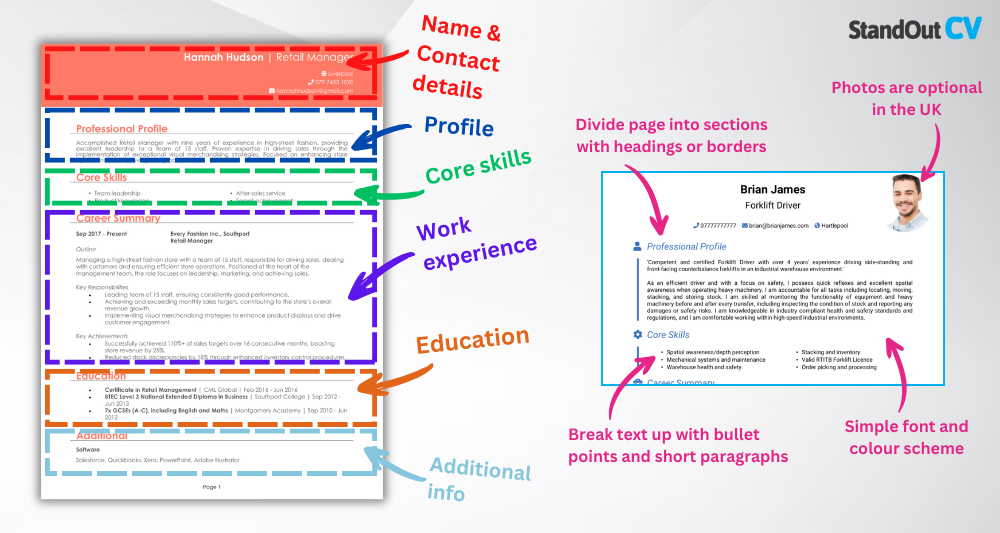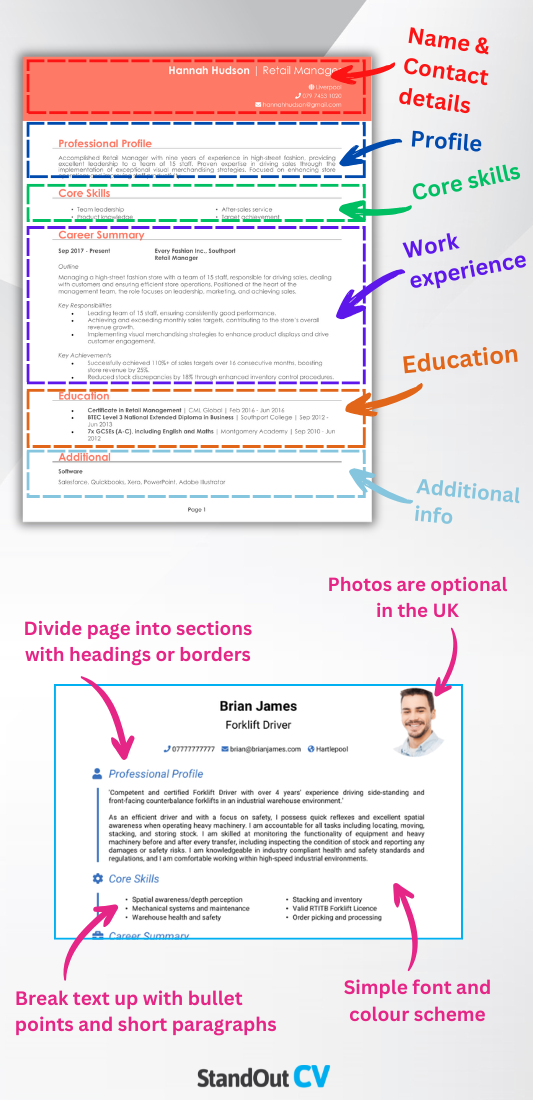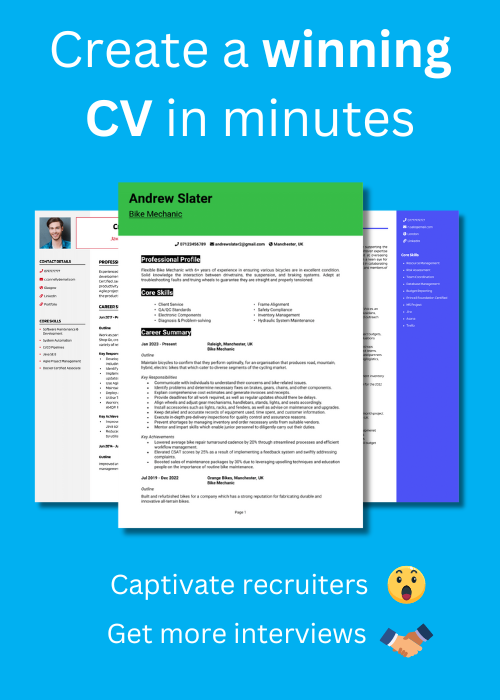Being around beautiful things is part of the job – but you do far more than just watch people look at paintings. You manage the logistics of making exhibitions run smoothly behind the scenes.
This guide will help you frame all that invisible work into a Gallery Assistant CV that stands out to hiring managers. The Gallery Assistant CV example will help you learn how to present your experience clearly and professionally.
Gallery Assistant CV sample

How to write your Gallery Assistant CV
Discover how to craft a winning Gallery Assistant CV that lands interviews with this simple step-by-step guide.
Art may be subjective, but a great CV isn’t. If you want to work behind the scenes in a gallery, you need more than a love of fine art – you need a document that shows your ability to make exhibitions happen without a hitch.
This guide walks you through each section of writing a CV and shows you how to turn your experience into a clear and relevant application that curators will actually want to read.
The correct structure and formatting for a Gallery Assistant CV


In a gallery, how something is presented matters – and your CV is no different. Even if your work happens in the background, the document that describes it needs to take centre stage. Good structure makes sure your qualifications and experience are easy to spot, while also showing off your ability to stay organised and detail-focused.
Here’s the layout to follow:
- Name and contact details – Ensure your name and personal details are easily visible at the top. A photo is optional and depends on the role.
- Profile – Craft a short introduction that showcases your professional background and key accomplishments.
- Core skills – Provide a quick overview of your top skills that show why you’re a great fit.
- Work experience – Outline your career progression in reverse order, emphasising your contributions and successes.
- Education – Provide details on your academic background, including certifications or specialised training.
- Additional info – You can add hobbies or activities here that reflect your enthusiasm for the industry.
Keep your font readable and your formatting simple. Use bullet points to break down the text – it makes things easier to digest. Divide your sections with clear headings and avoid visual clutter. Aim for a CV that fits neatly onto two pages in length and uses white space well – just like a good gallery wall, your format should never be crowded or hard to read.
CV profile for a Gallery Assistant


This top paragraph is your first impression – think of it as your label text in a new exhibition. In just a few lines, it should express your experience, knowledge of gallery operations, and what you’d bring to a team.
You don’t need to list every exhibition you’ve ever helped with – just focus your CV profile on showing recruiters that you’re dependable and understand the rhythm of gallery work.
Gallery Assistant CV profile examples
Profile 1
Professional Gallery Assistant with six years of experience supporting exhibitions, visitor engagement, and back-of-house operations in contemporary art spaces. Skilled in installation, handling of artworks, and front-of-house coordination. Committed to enhancing public access to the arts through excellent communication and event support.
Profile 2
Organised Gallery Assistant with four years’ experience working in commercial galleries and artist-run spaces. Proficient in coordinating private viewings, liaising with clients, and maintaining sales records. Knowledgeable in curatorial practices, archiving, and art handling procedures.
Profile 3
Enthusiastic Gallery Assistant with three years’ experience supporting temporary exhibitions and education programmes at public galleries. Comfortable managing reception duties, preparing interpretative materials, and working closely with curators and artists. Strong background in customer service and arts administration.
Details to put in your Gallery Assistant CV profile
Include the following:
- Where you worked – Mention the types of galleries or art spaces you’ve worked in and any notable exhibitions or collections.
- Your top qualifications – Note any training or academic background related to art, museum studies, or curation.
- Essential skills – Highlight your understanding of gallery operations, front-of-house duties, and art handling.
- The environments you’ve supported – Explain the scale or format of the galleries you’ve worked in (e.g. contemporary, heritage, commercial).
- Value delivered – Focus on what you helped achieve – such as keeping exhibitions running smoothly, supporting visitor engagement, or maintaining security and care of artworks.
How should you write a core skills section?


Your core CV skills section helps hiring managers see – at a glance – whether you’re equipped to thrive in their gallery environment. It’s a great place to show that you’re adaptable and experienced with both public-facing and behind-the-scenes work.
Use this section to reinforce your practical strengths, especially those relevant to the specific job. That might mean supporting installs, assisting visitors, managing ticketing, or working with artists. Be careful not to pad this section with generic traits – make sure each skill included is something tangible and role-specific.
Key skills for a Gallery Assistant CV
- Exhibition Setup and Installation – Assisting with the safe handling, positioning, and arrangement of artworks for gallery displays.
- Visitor Engagement and Information Sharing – Welcoming guests, answering questions, and providing information about exhibitions and artists.
- Artwork Handling and Preservation – Managing artwork movement and storage while ensuring conservation standards are upheld.
- Sales and Retail Support – Supporting sales of artworks, merchandise, or catalogues and processing transactions when required.
- Event Coordination and Support – Assisting with the organisation and delivery of private views, talks, and educational events.
- Inventory and Catalogue Management – Updating records and databases to track artworks, artist details, and exhibition logistics.
- Administrative and Office Duties – Supporting daily gallery operations through scheduling, correspondence, and data entry.
- Marketing and Social Media Support – Helping promote exhibitions through email newsletters, online listings, or social media updates.
- Security Monitoring and Artwork Supervision – Keeping artworks and gallery spaces secure during opening hours and events.
- Collaboration with Curators and Artists – Assisting curators or artists with exhibition preparation, research, and display concepts.
Writing about your work experience


Gallery work is often quiet and subtle – which makes it even more important to explain clearly what you’ve done. This section should highlight your contributions to exhibitions, openings, and day-to-day operations, as well as your ability to keep everything running in the background.
List each role in reverse order, starting with the most recent. Open each with a short paragraph introducing the gallery, the type of work experience, and the scope of your role. Then use bullet points to detail responsibilities and noteworthy achievements.
Formatting your job history for your CV

- Outline – Set the scene with a brief summary of the gallery, your job title, and the type of exhibitions you worked with.
- Responsibilities – Use action words like “assisted” and “coordinated.” For example: “assisted with the installation of rotating exhibitions” or “coordinated visitor bookings and front-desk operations.”
- Achievements – Show the results of your work. Did you help improve visitor experience? Did you support a successful exhibition opening? Include anything that demonstrates the positive impact of your involvement.
Work experience samples for Gallery Assistants
Gallery Assistant | Westborough Contemporary
Outline
Supported day-to-day operations at a busy contemporary art gallery specialising in emerging UK-based artists.
Responsibilities
- Welcomed visitors, provided exhibition information, and managed front desk operations
- Assisted in the installation and deinstallation of exhibitions, following artwork handling protocols
- Maintained exhibition spaces, monitored visitor behaviour, and enforced gallery policies
- Updated mailing lists and processed print and bookshop sales
- Helped coordinate private views, openings, and artist Q&As
Achievements
- Helped increase visitor engagement through improved signage and gallery layout
- Received positive feedback from visitors on approachability and knowledge of exhibits
- Supported six successful exhibition launches over 18 months
Gallery Assistant | Atelier Verdan
Outline
Provided administrative and operational support for a boutique fine art gallery focused on mid-career international artists.
Responsibilities
- Managed client appointments, viewings, and front-of-house responsibilities
- Prepared and maintained catalogues, sales documentation, and price lists
- Assisted with shipping logistics and condition reports for incoming and outgoing artworks
- Maintained inventory database and organised gallery storage
- Liaised with press and marketing to distribute exhibition invites and updates
Achievements
- Contributed to a 20% increase in gallery shop sales through improved layout and display
- Streamlined artwork intake procedures by introducing new logging system
- Recognised by director for reliability and professionalism with high-profile clients
Gallery Assistant | Calder Row Art Centre
Outline
Supported exhibitions and public programming at a municipal art gallery with a focus on local heritage and visual culture.
Responsibilities
- Set up gallery spaces for touring exhibitions and community events
- Delivered visitor tours and assisted with educational workshops and outreach
- Handled sales of local artist works and promotional materials
- Coordinated volunteer rotas and supported day-to-day gallery operations
- Compiled visitor feedback and assisted in reporting to funding bodies
Achievements
- Helped increase attendance to community workshops by 40% through improved scheduling
- Created visitor surveys used in funding applications and programme evaluation
- Assisted curatorial team in preparing interpretative labels and wall text
How to write your education section


You don’t need a fine art degree to work in a gallery – but if you’ve studied art history, curation, museum studies, or similar fields, this is the place to mention it. Just list your qualifications clearly and in reverse chronological order, starting with the most recent.
No need to list individual modules – but if your studies involved practical exhibition work, artist liaison, or conservation, you can briefly mention it in the description. Additional education like short courses or workshops in relevant areas are also worth including here if they support your application.
Recommended qualifications for Gallery Assistants
- BA in Art History or Fine Art – Shows strong foundational knowledge of artists, movements, and exhibition theory
- MA in Museum Studies or Curatorial Practice – Helps with career progression and understanding gallery operations
- Diploma in Cultural Heritage or Arts Management – Valuable for working in public galleries and arts institutions
- Short courses in art handling or conservation – Practical training that shows you’re prepared for hands-on duties
- Customer service or front-of-house training – Useful for galleries that receive high foot traffic or require public engagement





